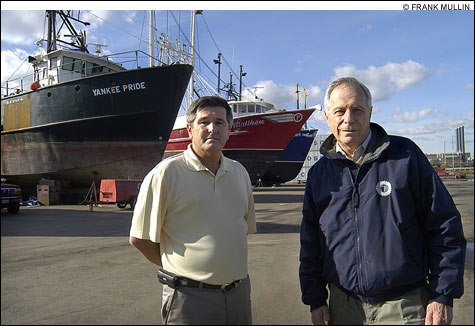High-stakes battle pits competing visions for key real estate
By IAN DONNIS | October 17, 2007

UP IN ARMS: Companies doing business along the working waterfront, like Jack Goodison (left) and
Promet Marine Service’s Joel Cohen, fear that rezoning the area for mixed use will spell their
demise. |
A specter is haunting the Providence waterfront — the prospect of change.
Take a look at the upper mouth of Narragansett Bay from a high point on George M. Cohan Boulevard, and the area looks much as it has for years: sun-dappled days offer glistening water in proximity to the ship repair work, numerous fuel storage tanks, and other gritty industrial elements that line much of the corridor along Allens Avenue.
If this picture doesn’t square with the kind of pleasant recreation and other public uses sometimes associated with waterfront property, it nonetheless represents a genuine economic generator and a source of good-paying jobs.
Yet various factors — particularly the ongoing relocation of Interstate 195 and the sparse amount of developable land in Providence — are combining to make the city’s waterfront a high-stakes battleground. And the outcome of these skirmishes will have statewide repercussions for years to come.
The biggest current area of conflict is the push by the administration of Mayor David N. Cicilline to rezone for mixed use the industrial corridor along upper Allens Avenue — a move that the businesses there fear will spell their demise. Propo¬nents, on the other hand, contend that enhanced residential and commercial development in the area would represent an economic windfall for the city, as well as other public benefits.
Less attention has focused, meanwhile, on the relocation of I-195 to a point south of the Fox Point Hurricane Barrier, due to be completed in 2012, which will free about 20 acres of land near downtown and the Jewelry District for reuse.
While this newfound availability of land near the center of an old New England city clearly represents a significant opportunity, there are sharply clashing visions: Providence officials seem to favor a focus on private development, while neighborhood advocates contend that maximizing public access to the nearby waterfront — with parks and other community-centered space — will offer the greatest and most widespread benefits.
It’s no surprise that these different views are coming into conflict. Even after a downtown building boom in recent years, Providence’s tax base remains in need of serious growth. In this respect, it’s understandable that the Cicilline administration — following on the heels of the Three Cities plan floated by Buddy Cianci in the late ’90s — is trying to foster fresh economic development.

Given all the longstanding national hype about Providence and the steady ascent of the city’s reputation, visitors might be surprised by how more development hasn’t taken place around the waterfront. The contrast is sharp compared with a city like Boston, where the Esplanade along the Charles River is a popular recreation area, and Boston Harbor is surrounded by restaurants, hotels, a public walkway, and other public and private attractions.
In Providence, neighborhood activists continue to fault some of the process issues surrounding the city’s planning and the state-mandated rewrite of its Comprehensive Plan, such as how the proposed Comprehensive Plan is being completed before neighborhood-based reports — which are supposed to underlie it — are incorporated into it.
Cicilline’s high approval ratings (64 percent in the most recent Brown University survey) show how these gripes haven’t come close to exacting a political cost. More to the point, with the mayor being among the Democrats gearing up for a gubernatorial run in 2010, he might be able to influence the outcome of these issues from a different vantage point before it’s all over.
So far, these disputes have involved a relatively small number of people, flying under the radar of most Rhode Islanders, but their resolution could have a broad impact, and for a long time. And, as with any kind of significant development issue, the big question remains whether the city can get the balance right.
 Topics
Topics:
News Features
, Thomas Deller
, David N. Cicilline
, Economic Development
, More  , Thomas Deller
, David N. Cicilline
, Economic Development
, Economic Issues
, Urban Planning
, Real Estate
, Business
, Joel Cohen
, Patrick Conley
, Brown University
, Less
, Thomas Deller
, David N. Cicilline
, Economic Development
, Economic Issues
, Urban Planning
, Real Estate
, Business
, Joel Cohen
, Patrick Conley
, Brown University
, Less 